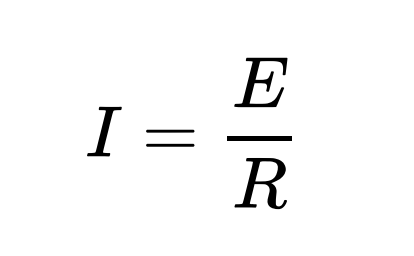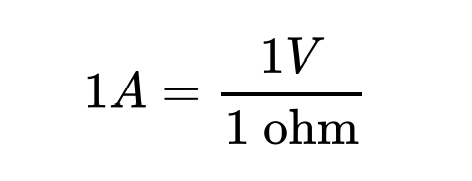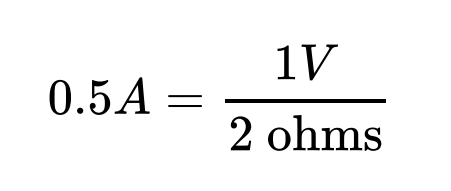This section provides a brief description of two of the most fundamental electrical relationships: Ohm’s law, which describes current flow, and Watt’s law, which describes how power is dissipated.
Ohm’s Law
Combining the elements of voltage, current, and resistance, George Ohm developed the following formula:

Where
- E = Voltage in volts
- I = Current in amps
- R = Resistance in ohms
This is called Ohm’s law.
Let’s say, for example, that we have a circuit with the potential of 1 volt, a current of 1 amp, and resistance of 1 ohm. Using Ohm’s law we can say:

Let’s say this represents a tank with a wide hose. The amount of water in the tank is defined as 1 volt, and the “narrowness” (resistance to flow) of the hose is defined as 1 ohm. Using Ohm’s law, this gives us a flow (current) of 1 amp.
Using this analogy, let’s now look at the tank with the narrow hose. Because the hose is narrower, its resistance to flow is higher. Let’s define this resistance as 2 ohms. The amount of water in the tank is the same as the other tank, so, using Ohm’s law, our equation for the tank with the narrow hose is:

But what is the current? Because the resistance is greater and the voltage is the same, this gives us a current value of 0.5 amps:

Watt’s Law
Electric power is the rate at which energy is transferred. It’s measured in terms of joules per second (J/s). One joule of work done every second means that power is dissipated at a rate equal to one watt (W).
Given the few basic electricity terms we know, how could we calculate power in a circuit?
Well, we have a standard measurement involving electromotive force, also know as volts (E).
Current, another of our favourite electricity terms, measures charge flow over time in terms of the ampere (A), which equals 1 coulomb per second (C/s). Put the two together, and what do we get? Power!
To calculate the power of any particular component in a circuit, multiply the voltage drop across it by the current running through it.
For instance, if current flows at a rate of 10 amps while voltage is 10 volts, then the circuit dissipates power at a rate of 100W.
Reference
Basic Motor Control by Aaron Lee and Chad Flinn is used under a CC BY 4.0 Licence.